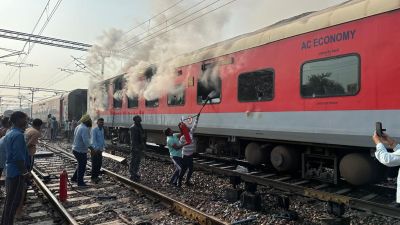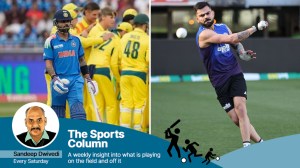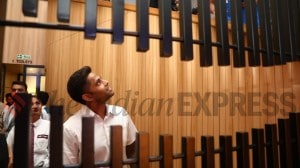Commercial break
Last week,The Sunday Express focussed on paid content in the print media. We now look at how advertising has become...
Last week,The Sunday Express focussed on paid content in the print media. We now look at how advertising has become part of news in the broadcast business
About a month ago,some like-minded women,including a few actors,launched a social campaign called War Against Lazy Stubble (WALS),targetting men who are too lazy to shave. The movement found a ready supporter in Gillette India,a leading shaving products company. Gillettes Shave India Movement,which has been around for a year,was prompted,it says,by the finding of a consumer survey that clean shaven men are likely to be more successful and popular among women. The movement has been covered by well-known English news channel CNN-IBN,which has been running a series of shows comprising news features,interviews of celebrities as well as panel discussions on the issue: To Shave Or Not.
To Shave Or Not,incidentally,is also the slogan of the movement launched by Gillette. CNN-IBN and Gillette both did not respond to questions on the initiative. An executive of a public relations agency representing Gillette,however,said that CNN-IBN was part of the companys larger marketing gameplan to catch consumer attention from all possible platforms for its newly launched top-end product Gillette Mach3.
The executive said the exclusive partnership
between the news channel and the company is now over. A website on War Against Lazy Stubble,http://shaveindia.com,Gillettes latest initiative,however,says its copyright rests with Global Broadcast News Ltd,the parent company of CNN-IBN.
Advertiser-funded programmes
Branded content or advertiser-funded programmes are not new in the broadcast business.
Whats new is that from being limited to entertainment,theyve now entered news,once considered a sacrosanct space. The change has come in the last two years. Brand alignments with news broadcasters,media partnerships and even fully-funded programmes are the new reality on the television news business.
According to at least 10 senior professionals working across news channels,advertising agencies and public relations firms,a varied set of commercial solutions is available to advertisers to align with news channels. Prominent among these include on-screen brand integrations (see box),producing exclusive shows focussed on particular brands or companies,airing shows that are an extension of an ongoing marketing campaign of an advertiser,media partnerships and interviews and profiles of top executives of companies,or celebrities.
A senior editor of a leading news broadcaster admitted that in a week,around eight to 10 half-an-hour slots are reserved for advertiser-funded programmes. She,in fact,was unhappy that her broadcast company lacked the right kind of marketing attitude. On an average,20 per cent of our shows are funded by advertisers whereas some of our rivals have at least 30-40 per cent of such shows on air, she says.
While such relationships are now accepted in the business,the issue that is increasingly being raised by concerned media observers is that of disclosures. It is important that channels come clean on such tie-ups, says former chief Justice of India JS Verma. He is also the chairperson of the News Broadcasting Standards
Authority set up by industry body News Broadcasters Association (NBA) to look into complaints against news channels.
Though there are some who make the required disclosures,the majority does not. G Krishnan,executive director and CEO of TV Today,the company behind Hindi news channel Aaj Tak says: In case there is any advertiser funded programme,it clearly mentions it is an advertorial.
A spokesperson for NDTV,who admitted that they run programmes funded by advertisers,said: With a title sponsor in place,disclosure would be very funny… theres always the advertiser name in the title.
Senthil Chengalavaran,president and editorial director,TV18 Business Media,the company that runs channels such as TV18 and CNBC Awaaz,said: If you have the name of a company in the show,it means it is funded. These shows do not have any editorial support.
Business news channels have taken such tie-ups to a different level altogether. For instance,they offer extensive services that include organising events for advertisers,inviting guests in their editorial capacity to such events,promoting the events on their network,airing them and also carving out editorially-led programmes from such events such as panel discussions and interviews. According to industry watchers,the Network18 Group runs divisions such as Focus and The Cell,whose primary mandate is to organise events and create advertising for such events.
These services come at a hefty price. There are no fixed rates but the price for a complete package,that includes repeat telecasts,varies from Rs 20 lakh to Rs 25 lakh. Partial services,which means either only the event or only the promotion,costs less, says the CEO of a public relations agency that has organised several such events for its clients. According to people in the industry,panel discussions that run into half-an-hour are priced around Rs 8-12 lakh.
Despite repeated attempts,The Sunday Express could not a response from Raghav Bahl,the founder and managing director of Network18 Group that runs channels such as TV18,CNBC Awaaz,CNN-IBN and IBN7; Rajdeep Sardesai,editor-in-chief,CNN-IBN,and Prannoy Roy,chairman,NDTV Ltd.
Choice or compulsion?
In India,private television news has been around for less than a decade. In these years,the industry has grown rapidly. According to the 2008-09 annual report of the Information and Broadcasting (I&B) Ministry,211,or 54 per cent of the total number of 394 registered television channels in the country,are news and current affairs channels. All of these are not operational yet,yet they comprise the largest chunk among all genres put together.
Such a large number of players has meant a splintered viewership and a thinner advertising pie. News channels are also considered to be largely driven by a male audience,an audience that is not the primary target of most consumer goods companies,one of the biggest advertisers. Smaller and skewed viewership,therefore,has limited the channels ability to command decent advertising rates. According to estimates from media buyers,while a 10-second ad spot during primetime on a general entertainment channel costs anywhere between Rs 50,000 and Rs 2 lakh,a similar ad spot on national news channels could be bought for anywhere between Rs 1,500 and Rs 5,000.
The biggest challenge,however,is revenue leakages in the system. Globally,more than 70 per cent of broadcast revenues come from subscriptions whereas Indian broadcasters get less than 20 per cent of their legitimate income because of the under-declaration by cable operators, says Barun Das,CEO,Zee News. Since advertising is the sole source of sustenance,there is a pressure on news broadcasters to expand and tap all possible advertising opportunities.
Yet,as Das argues,designing or airing content for monetary considerations is unacceptable. News is about credibility and if channels succumb to advertisers pressure and put a price to their editorial content,they will only hurt themselves in the longer run.
Aaj Taks Krishnan agrees. The role of a news product is to hold a mirror to society. Thus,credibility is the paramount criteria for building a successful news brand.
Channels of politics
Interestingly,there have not been any indepth expose on how politicians have used news on television to further their image. As several independent media professionals point out,its so blatant that it needs no expose. It is known that a majority of news channels in the country are directly or indirectly owned by politicians or their close associates. We know even some political parties own such channels and they are bound to support their own case and run down their opponents, says Anil Bairwal,national co-ordinator of the New Delhi-based Association For Democratic Reforms (ADR).
In an analysis of media expenditures by candidates in the 2009 general elections,the ADR found that most candidates of major parties such as the Congress and the Bharatiya Janata Party,reached nowhere close to the maximum expense limit prescribed by the Election Commission. State-wise spending revealed that total average spends across states were less than 50 per cent of the prescribed limit. Isnt it ironical that while all political parties and candidates have been complaining that the cost of media buying has sky-rocketed and the current limit of Rs 25 lakh is too less,they havent even exploited the official limit, asks Bairwal. Isnt it implicit that the parties and the candidates have spent on media through devious routes?
But media experts say its not easy to take news channels to task. It is a live medium. Before you realise that something is wrong on a particular show,it is gone, says Madabhushi Sridhar,a professor of media laws at Nalsar University of Law in Hyderabad. It is nearly impossible to record everything and create a log of who showed what. Besides,no independent agency in the country keeps such records, he says. One of Sridhars associates,an independent Lok Sabha candidate in the 2009 elections from Andhra Pradesh,has filed a case against one of his rivals alleging misuse of media. We have managed to collate newspaper clippings to support our case but it has been difficult gathering televised content.
Absence of a watchdog
Unlike the print media,television news does not have an independent watchdog. Its an absence that worries many. Recently,there have been several complaints over the news channels lack of accountability with the issue being been raised in Parliament too. Information and Broadcasting Minister Ambika Soni has cited broadcast regulation,especially that of news,by an independent body as one of her foremost concerns. She has even admitted receiving complaints of malpractices in the business.
On their part,news channels have consistently opposed outside regulation. The News Broadcasters Association (NBA),a body represented by all leading news channels,has drafted a content code,which though not binding,is expected to serve as a guideline for editorial as well as advertising practices for its members.
The NBA,however,did not answer a questionnaire set by The Sunday Express on allegations of paid content. Justice Verma,though,agrees that there is a lot of scope for improvement in the way news channels currently work. There are various aberrations and the perception about the news business is reprehensible, he says.
How the industry corrects its course remains to be seen.






- 01
- 02
- 03
- 04
- 05

























